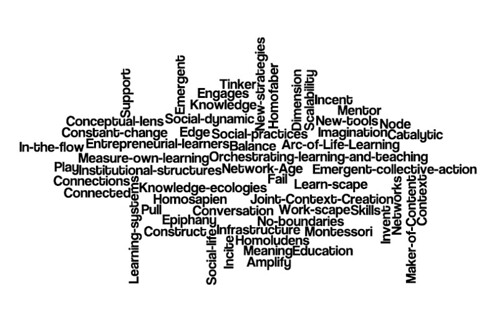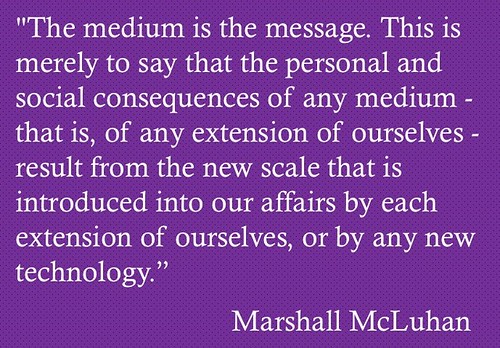This is the original script for the Iowa State Cooperative Extension Virtual Conference keynote address. The presentation can be found
www.slideshare.net/aafromaa. The recording of the keynote can be found
https://connect.extension.iastate.edu/p2ehodt6g48/
Continuous Beta and a
Healthy Dose of Paranoia
Before we get started I want to applaud you, the organizers
of this conference, and your administration for developing a state conference
different from any other. Cooperative Extension has conducted other virtual
conferences—the first one I spoke at was in 2009 when North Carolina State held
a statewide technology virtual conference. eXtension has hosted several virtual
conferences. This one, in Iowa, provides the efficiency you would expect but also
folds in other concepts like a flipped classroom and a blended approach. I
congratulate you on trying something new and taking a risk.
My discussion today will be based on a few concepts of
changes and why we need to look at our work and the way others work differently.
We will also discuss some skills we need to work in this new environment. We
will look at how a fast and continuously abundant flow of information,
including noise, makes it harder for us to listen and to be heard. It also
gives us great opportunities for inclusion and diversity and how “do it
yourself” creativity, innovations, and research are important to our work. They
cannot be ignored. Hopefully, the discussion today will help us understand how
interconnected we are to the forces of change.
The part of the title “Continuous Beta” is the first concept
of change we will discuss.
Continuous Beta
Are you, both personally and professionally, and is
Cooperative Extension ready to perform, produce, learn, connect, communicate, and
make a difference in a perpetual beta environment? The term perpetual beta
comes from the idea of keeping software in a beta development stage for an
extended time maybe indefinitely. A beta stage is where software is usable but
not completely tested in multiple and unforeseen situations. The advantage of
having software or some systems in perpetual beta is that these systems can be
changed rapidly allowing for continued development. Continuous beta also means
that the system is agile.
Obviously continuous beta is not suitable for mission
critical systems—such as airline traffic controls and selling products if that
is your bread and butter. A beta stage to Cooperative Extension is attractive
because the environment in which we are trying to make a difference is complex and
influenced by fast flowing and abundant information from vast and diverse
sources.
As we look at solving complex problems, we may want to look
Dave Snowden’s Cynefin framework. Complex problems have no known solutions
and to solve complex problems we need to probe sense, respond, create emergent
solutions and then repeat as we learn. So you see there are reasons to develop
a Beta mentality about our work. We are in a time that Cooperative Extension is
needed more than ever, but our successes will depend on whether we can listen
and assess needs in new ways, be agile, rapidly rapidly, include others outside
of the land-grant system, and be willing to experiment.
The Connected Worker
The Connected Organization
The next concept of change is Connectedness. We are now connected in ways we have never
before. We can Skype across the world, we can conference, share documents, and simultaneously
or asynchronously edit those documents, we can share our most endearing, most
embarrassing, and most mundane moments with select friends and with the world. We can play games of strategy, bartering, and
power with people all over the world and while playing these games we can have social
interactions—conversations beyond the game itself.
We can take a class with thousands of others. In that class,
we can select who we want to collaborate with, study with, and help and get
from, with the intention of never meeting our classmates or our teacher. We can
create music, movies, computer programs, and science projects with strangers.
We can play music with others in outer space. If we are not the connected
worker, we simply are not reaching enough people with the same goals.
I know many of you are very well connected in your local
communities. That has been Extension’s model. Embed Extension agents in communities
to build credibility, access needs, and help to solve problems, and change
behavior—all to improve lives and our communities. The 2008 Copernicus survey
found that only 27% of the population had ever heard of Cooperative Extension.
Only 11% had used Cooperative Extension at least once in their lifetime. When we
look at the numbers in the 18-35 year old age group, these numbers are
incredibly dismal. I suspect the numbers in Iowa are better than the national
numbers—but not greatly. Cooperative
Extension simply has to reach be more relevant, reach more people and brand
ourselves better.
Nodes of Networks
The fact is that we are part of many networks.
In the 50s and 60s and possibly the 70s, Cooperative Extension
could set the norms of communities. Often times, the county agent was one of a few
people in the community besides the local doctor, veterinarian and possibly the
preacher, who had a college degree. We still hear stories today of how
Extension agents were the connection to the land-grant universities. In strong
4-H programs, this may still be true.
However, the environment has changed and we are not the only
ones in local communities with college degrees. This is a success of
Cooperative Extension—we helped people in local communities understand the
value of higher education.
We simply can’t be setting the norms if people don’t know
who we are. Instead we are now members or nodes within many networks. These networks
are interconnected. The bigger the node—the more connected and possibly more
influential. Our individual roles vary across networks.
When we think of ourselves as being a node within a network
rather than being the one person of authority, we should change the way we do
business.
More people can develop content. Yes, there is a ridiculous
amount of noise. We also know that serious amateurs are doing research and are
creating content that is research-based. Yes, some of content generated is biased. But remember, if we are not
setting the norm (albeit we probably can name few exceptions), and we are nodes
within networks.
Another reason we are not setting norms in communities is
that the amount of information today available is almost incomprehensible. Every
two days we create as much information as we did from the beginning of time up to 2003.
Let’s look at some examples.
Frank Kovac, a Wisconsin millworker, always dreamed of becoming
a director of a planetarium. However, college math was definitely a trouble
spot. Without a college degree, he was determined to fulfill his dream. He
built his own rotating planetarium and you can visit the planetarium in
Wisconsin.
A 15 year-old finds a new way to detect pancreatic cancer.
This new way is simpler and less expensive and can be performed much earlier
than the current method.
A homeless man finds a way to hack sites and becomes
employed. Isn’t this exciting? Everyone can make a difference. Serious amateurs
can provide innovative and useful contributions.
So what is Extension’s role in local communities and online?
I say this as if local communities and online communities are separate—they are
not. We have only one life. The two are not separate. Local communities extend
themselves online as well. We are members of interconnecting networks.
Communications and knowledge expertise is no longer in a hierarchy
one-to-many structure like many traditional educational models. There is now dynamic
flow of power and authority based on knowledge, trust, credibility and a focus
on results, which is enabled by interconnected people and technology. In other
words, a few experts no longer hold the authority of knowledge and information.
Harold Jarche says that organizations need to learn as fast as their
environments.
Is Cooperative Extension learning as fast as the economy
changes, adjusting as fast as technology advances, and adjusting to the
increasing flow of information?
Can we learn to work in a wireachy knowledge environment
rather than hierarchical one?
Disruptive
Innovations
Disruptive technologies are innovations that put unwieldy
businesses out of business. Kodak did not respond to the rise of digital photo
technology and the change in customers’ and potential customers’ behavior. Are we in Cooperative Extension blind to the
pressures of public accountability, funding responsibility, and changing
information political, and economical environment?
Disruptive innovations provide new value through new
products, processes, or concepts. Extension work can be affected by disruptive
innovations. Mobile computing has led to mobile lives. According to Prosper Insights & Analytics™
60% of smartphone owners say they cannot live without them.
Wearable computing and Google glasses will bring new meaning
and opportunities to ubiquitous computing, visual application, and geolocation.
Wearable computing will provide new opportunities for sharing and contextual
information. Wearable computing will provide new challenges particularly to privacy
concerns and information filter abilities. Google glasses and wearable
computing increases data, choices, sharing, and perspectives in ways we cannot
imagine.
Let’s consider what your own faculty described. Nancy Franz
and Ronald Cox in the Journal of Extension offer these reasons as to why
Extension does not embrace disruptive innovations as threats or opportunities.
The bolded ones are the ones I am most concerned about.
·
Lack of urgency to innovate
·
A lack of
diversity in customer base and staffing
·
Strong linkage to academia, bureaucracy and
historic slowness to react to change
·
Lack of operating with a business mindset
·
An expert
model paradigm rather than collaborative paradigms with clients
·
Over reliance on rural customers
·
A lack of customer management/tracking over time
·
Status
quo
·
Over dependence on past sources of funding
The challenge is to not get in the way of innovation and to develop
structures that support the messy process of experimentation, creativity, innovation,
and failure.
Big Data
What do we mean by Big Data? Everything—purchased, searched,
shared and every response and location can be and will be recorded. We have
entered a time of having increasing information on almost everything. Companies
use this information usually in aggregate to targeted marketing messages and
these tactics are becoming more and more just-in-time.
For instance, at big sports events, phone companies gather
data on users within in specific location and the data are combined with
demographic data and are sold in aggregate to marketers. Companies can
determine if sponsorship at a venue drives sales. Big Data allows companies to
see trends and patterns to make production and service decisions as well.
Big Data also provides community, health, environmental, finance,
and economics information. We will continue to amass more data that can better
predict epidemics, for instance. Big Data means that more sophisticated analytical
tools need to be created. Not only will we need better decision tools, but also
knowledge workers will be called on to have higher levels of sense-making
skills and programming skills.
On a negative side, there is no doubt that people will grow
more concerned over privacy invasion.
Extension’s role is to understand the implications and how
to decipher and make sense of findings. We have great potential in helping others
understand the benefits of big data and the changes in privacy. We need to be
able to filter and interpret the information.
We must be agile in working with a variety of organizations
in coming up with practical solutions—possibly on the fly. In times of crisis,
we may not be able to have tested research in hand. Are we positioned to react
in minutes, hours, days, and weeks? Months will possibly be too long.
Race with the Machine
Economy
We are now already in a data, knowledge, and service economy.
Big data, machine automation, machine learning, artificial
intelligence, knowledge automation and services are changing economies.
MIT
professors, Erik Brynjolfsson and
Andrew McAfee, tell us that the traditional method of measuring economic growth
does not accurately measure the value in innovations, services, and current economic
changes. The knowledge and service economy does not adjust to government and
other interventions as when we were in the industrialization age. During the
industrial age, manual laborers shifted from rural locations to urban
locations.
Innovations in service industries and technological advances
don’t displace only the manual laborers. Machine/computing automation has
already replaced people like bank tellers. Knowledge automation or artificial
intelligent systems are replacing tasks performed by higher level knowledge
workers, such as legal staff and some accounting professionals. Computing
systems now perform legal discovery, costing a small fraction of legal staff
and these systems are much faster and more accurate. Hopefully, these systems
mean lower billed hours. These systems also find documents that are related
through concepts—related concepts that could be helpful to cases.
You may ask then where legal staff members who have done
these kinds of services go. It is possible for them to “step down” in the
career ladder. Or, they could become better sense-makers with better analytical
skills to “move up” in the career ladder. Legal staff members now are called to
curate information and organized the most important information found through
automated discovery.
As smart as these systems are, the best knowledge systems
are those where humans and computers collaborate—working together. A new
thought on virtual collaboration, heh?
The good news about improvements in technology is that it
creates massive wealth; the bad news is that not everyone shares in the prosperity.
You could be listening to all of these changes and question
whether Cooperative Extension can survive or whether you, as an Extension
professional, are ready or willing to get ready for all of these changes? You
may also be thinking that these changes are not going to affect your local
community. I would caution you on having that kind of thought. Interconnectedness
cannot be underestimated giving you power or making you insignificant.
But I have hope. I have a lot of hope. Cooperative Extension
is needed more than ever. But, we simply can’t wait until “our clients” adopt
technology—I would argue most already have. And remember we are not reaching
enough people. For those people who we are not reaching and should, how do you
think they are working in this connected world?
Where do we start? What skills and mindsets are needed to
succeed? Most of the skills and approaches fall in an individual domain to take
responsibility for developing. But, please also think about the culture and
leadership can influence a learning organization.
Skills need for the
Connected Worker
Curation
Curation is a perfect opportunity for Cooperative Extension.
Curation is what we already do at the local level, particularly one-to-one
interaction. Local agents put information into context, helping clients
understand benefits and options. The online curation is an aggregation of lots
of information from lots of sources, filtering the most important, making sense
of the information within relative points of context, and designing
discussions, articles, and graphics in ways to help others understand. Curation
is much more than aggregating. It’s making sense of all that we know at a
moment of time. Curation should be done in a public, open, shareable way so it
is use can be multiplied and scaled. Curation can be done with others. Virtual
collaboration enriches the curated product.
Extension professionals are groomed to become online
curators and providing thoughtful filters. Some example curation tools are:
Scoop.it Community Gardens –Illinois
Twitter Paul McKenzie, Ag Agent
LinkedIn: Early Ed for Military Families
Paper.li Stan Skrabut, Wyoming
Kurator Bob Bertsch, ND State
Storify This presentation
Informal learning
Only 10-20% of learning takes place in formal settings. Informal learning is the responsibility of the individual. The opportunities to
connect with others like yourself and those you would never have a chance to
meet are endless—Embrace it. The skills needed today are changing as fast as
the environment is changing. It is essential that one finds new information and
keeps up to date. But keeping up date with only the latest journal findings will
keep us woefully behind. As professionals we have been called change
agents—change agents do not wait until their clientele has adopted technology
to adopt technology—change agents adapt technology first.
One tactic of informal learning is to have planned serendipity. That is to put yourself in communities that
you have never been a part of. Learning a technology just because. Learning a
concept outside of your focus area. We don’t come up with new ideas by
continuing only the connections we had. We develop new ideas when we are
exposed to a diverse opinions and knowledge.
Technologically Adept and Socially Savvy Online
Staying connected means that one has to become technologically
adept. This is one of the 10 skills named by the Institute of the Future. Along
with the technology skills we in Extension must learn to connect, converse,
build, and maintain relationships like we have traditional taught young agents
as they began their work in local communities. Another skill in the Institute
of the Future report is to be able to virtually collaborate. We don’t have the
luxury physical meetings to do our work effectively.
A professional and staff development unit can carry you only
so far. You have to be assertive in learning.
In fact any Extension professional who is not willing to learn is not
only is hurting him or her self but is doing a disservice to the greater
Cooperative Extension system and to his or her community.
Some suggest that college graduates today need to know basic
HTML—the programming language behind every web and mobile application.
The eXtension Network Literacy Community of Practice is an
excellent way to get started. They use a variety of ways for professionals to
learn including virtual immersive learning.
eXtension’s Learn site provides webinar offered by different
institutions. For instance Stan Skrabut from Wyoming lists all of his social
media sessions on eXtensionLearn and welcomes others from other institutions.
Balancing new and old
Knowledge workers will need to learn to balance integration,
oversharing, massive information, noise, finding, and sharing the relevant. Accountability is not only reserved for
government and watch groups, but now is possible at the ground level. We will continue
to balance calls for rapid responses and try to stay focused for the long-term
goals.
Society will struggle with more polarized politics and
opinions, possibly enabled by sharing and connectedness. Extension will
struggle as how to work with diverse audiences who have much different views
than we do personally.
Balancing will evolve. We can start by not polarizing the
questions we have. Why do we say face-to-face is always better? Instead maybe
the question is what are advantages and disadvantages of face to face and
virtual? Or maybe we should ask how we can enhance the effectiveness of both by
merging them? For instance look at how television networks are embracing and
capitalizing on social media around movies, showing and big sporting events.
Confident paranoia
This is probably the only time you will hear the word paranoia
in a positive sense. It is a skill every advisory council member, program
assistant, local agent, campus faculty, middle manager, administrator, and
university president should develop.
Confident paranoia means you are not comfortable where you
stand as a professional and you are not comfortable where your organization
stands. Confident paranoia means you know there is always someone or something
that can take over and that there are ways to adjust and serve better and
differently.
I recently met a young man who played football for a
mid-major Division I school in the Southeast. He later played a short while for
the pros. He was teasing a few of us about the Auburn and University of Alabama
football rivalry and then he got serious and he explained why he respects
Alabama’s Coach Nick Saban—the University of Alabama has won 3 national
championships under Coach Saban since arriving at Alabama in 2007. He also won
a national championship while at LSU years before.
The young man explained how young athletes (the ones who get
recruited to major Division I schools like University of Alabama, Ohio State,
and Notre Dame) have been told that for the last 8 to 10 years of their lives that
they are great because of their abilities, strength, size, speed, and athletic
smarts. In the local communities, college potentials are held high on a
pedestal—with pride as locals want these kids to succeed at the next level.
Saban recruits these great athletes—like all great coaches. These
athletes become Coach Saban’s first, second, and third string players. Saban
does not tell his players how great they are. Instead, Saban continues develop
players making each one better. If they want to keep playing they have to keep
getting better. This is a healthy dose of paranoia—knowing that someone can
take your place.
Imagine if Kodak had had a confident paranoia when making
the decision not to embrace digital technology. Imagine if Blockbuster had had
a confident level of paranoia and reorganized and rebuilt the business based on
buyers’ changes in behavior.
In the case of Saban’s great college football players, they,
most of the time, can identify the next player and compare the next player to
his own strength and weaknesses.
In Cooperative Extension, we can’t necessarily identify the
next player, but we can see the horizon. Being a little paranoid should lead us
to make changes that keep us from becoming obsolete.
The complexities of society, environment, energy, public
health, knowledge, data and service based economy, and feeding 9 billion people
mean that Cooperative Extension is needed more now than any of us can remember.
But we can’t solve problems, make a difference and reach enough people if we
don’t embrace the opportunities and benefits of working differently. This means developing individual skills, and
organizationally letting go of some controls, and learning to probe, sense, and
respond to emergent problems.
It is an exciting time to be working for Cooperative
Extension because our potential for making a difference could not be better.
My challenge to you is find one or two things you will learn
to do differently with the goal of reaching more people, connecting with
someone with whom you would not normally connect, or collaborating to develop
programs with someone outside of your normal area of work and comfort area.
I want to thank you inviting me today. Also I want to give a
shout out to Robin, Lisa, Brian, Daniel, Nancy, and others for guiding me and
helping me feel comfortable with the broadcast.
As always, the Iowa State web conference crew is a topnotch group to
work with.
References:
Marketing and cell phone companies
Steven Rosenbaum design and curation
Informal learning
10 Skills needed for the future
 Roses are red, violets are blue
Roses are red, violets are blue






